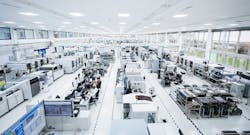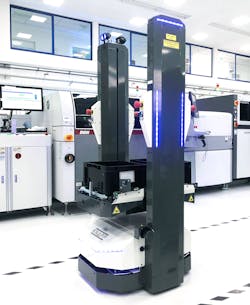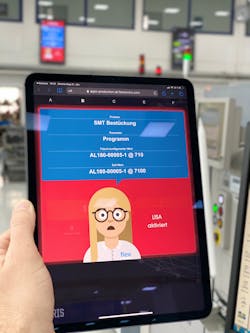Are exemplar smart factories better called genius factories?
Global manufacturing, supply chain and solutions partner Flex’s plant in Althofen, Austria, manufactures more than 500 medical, industrial and automotive products including drug delivery devices, fleet management systems, GPS modules and precision measuring solutions.
Flex began digitization efforts at the Althofen plant in 2010 and by 2016 amply demonstrated its friendliness to Industry 4.0 technologies, including cobots and automated guided vehicles (AGVs). The plant also ran enterprise resource planning (ERP) software. This still wasn't enough for the plant to keep up with long-term growth targets.
“In Althofen we do about 10% more complexity, I would say, every year. Meaning we placed 10% more components, and mostly this ends up in 10% more end product as well,” says Paul Baldassari, executive vice president at Flex. “We have to do that roughly with the same number of people. We needed to do something that is a step function in efficiency. And that's where we started in Althofen to think differently.”
Thanks to those efforts and their impressive results, in September 2021, the World Economic Forum admitted the Althofen plant into the Global Lighthouse Network, a who’s who list of factories that demonstrate the best of what Industry 4.0 can accomplish.
Weaving the IIoT Web
Flex began rethinking Althofen plant operations in 2016 and started with a massive IoT project in late 2017. More than 500 IIoT devices currently operate at the plant, with more added regularly. Baldassari says that most of the plant’s equipment uses sensors to capture data to feed into an advanced analytics platform.
“For example, we use reflow ovens. It’s a long piece of equipment that contains heat chambers where reflow and soldering happen. It requires a drive chain to move components through the heat zones, and the drive chain needs lubrication to work properly,“ Baldassari says.
“We installed IoT sensors that read the consumption of the motor on the drive chain,” Baldassari continues. “When you look at this data, you can see when the drive chain has a challenging time moving and requires more power. When the power consumption reaches a certain threshold, a ticket in the maintenance department is automatically created so they can add more lubrication and avoid potential downtime.”
IoT devices measure temperature, humidity and machine voltage. They even monitor where water pipes come into the factory, sensing for steady vibrations or leaks to address.
“Most of our electricity consumption comes from our machines running. So, by monitoring all the different equipment and knowing when you’re going to have downtime, for example if you’re not going to use a reflow oven immediately, you can start cooling it down and reducing airflow. You can do similar things on other machines, and they use 60% to 65% of all the energy that you use in the factory," Baldassari says. Thanks to an IoT-based real time energy monitoring system, that identifies waste and leakages and helps avoid peak loads, the Althofen plant has reduced its energy needs.
Work continues on an IoT-based system that notifies operators via phones or wearables with important updates or tasks that must be carried out. “We are constantly developing solutions in small sprints, working in an agile way for requirement changes. While the IoT process started in 2017, the team has constantly added new IoT sensors and devices to the factory since then,” Baldassari says.
“The team also meets daily to have stand ups with shop floor operations where they talk about what is working well, what needs help and what challenges might pop up soon. To solve these challenges, the team looks to IoT," Baldassari adds.
The plant’s analytics platform ingests the data generated by the IoT infrastructure, and the data science team uses this information to create a digital twin of the factory and train machine learning models that optimize operations. For example, simulation modeling predicts required maintenance and unsupervised machine learning detects anomalies.
Employees using tablets or other HMIs may tap into the analytics platform and create custom, real-time dashboards to monitor data relevant to current tasks. “Essentially, we work to democratize access to data. Whoever wants access can get it so you can do your own reports and draw your own conclusions,” Baldassari says.
Smart Material Movement
In mid-2018, Flex began developing an agile smart kanban material delivery system for the plant, culminating in an algorithm that every hour looks ahead at the production schedule for the next four hours and plans material movement accordingly. Consumption rates of pick-and-place machines, barcode scanners in the warehouse and scheduling and planning systems are some of the sources feeding the algorithm.
“The algorithm checks what material is currently loaded on the other production lines we have, the consumption rate on the production lines of the material that is currently loaded there. [It’s] doing the calculation to know if material will be left over or not or if everything will be consumed that is currently loaded,” says Martin Stefan, director of Worldwide Digitization & Factory 4.0.
Prior to 2017, to make sure materials were always readily on hand to replenish the lines, a considerable amount of material sat on the shop floor in racks. Operators had to manually search through the racks to get the materials they needed to replenish the lines.
Today, component packaging reels are stored in material towers on the production floor. When an operator requires a new reel to splice into a machine (i.e. to replenish the components) they scan the barcode of the component. The material tower then readies a fresh reel for the employee to pick up.
Employees on the floor place reels into x-ray counters, to count the number of remaining components, before sending the reels back to the warehouse.
The materials planning algorithm also draws data from these counts.
Employees in the warehouse receive pick instructions on mobile devices, telling them which materials to load onto AGVs that then deliver the materials to the appropriate material tower on the floor. The algorithm also calculates which materials to return to the warehouse from the shop floor if the upcoming four-hour schedule doesn’t require them.
The algorithm-driven materials system removed the need for the material racks on the shop floor and created room to install additional production lines.
Meet LISA, the Friendly Virtual Assistant
Surface mount technology (SMT) lines, the beating heart of the Althofen plant, mount electronic components onto circuit boards. If two products on a line fail quality checks the line stops and operators have to diagnose the problem. Even just a few stops a day provide big headaches when the SMT lines produce volumes like Althofen's.
“We now have roughly 900 changeovers on an SMT line per month. An average production batch is between two to three hours,” says Iris Leitgeb, strategy and business excellence manager. “The quantities we produce for a certain product in a year range between 100 pieces and 3 million pieces, so it’s really a huge level of complexity that we handle here.”
The software adjustments required during rapid and frequent changeover provide a lot of opportunities for error. Flex therefore employs a system conceptually similar to advanced car braking systems that counteract skidding by automatically applying brakes or reducing engine power. The system prevents SMT lines from running if incorrect settings could lead to equipment damage.
While Flex intended the system to remove stress from line operators by preventing them from accidentally damaging the lines, the company realized it might also feel oppressive, like a machine constantly peering over operators’ shoulders and checking their work. The software needed a friendly face. This led Flex to develop a 2D cartoon avatar called LISA, or Line Stop Assistant.
“LISA is connected to several data sources, including our training record system to prevent untrained people from accessing the system as well as our electronic process instruction and MES system, which serves as an electronic poke yoke [mistake-proofing] solution,” Baldassari says. “In addition, LISA is connected to the process equipment via sensors and this algorithm can stop the line in case a misalignment is found.”
“It’s a concept which has been given a face,” says Stefan. “Digitization is a good solution that is scalable and robust. But don’t forget about the people that you might impact with it. We consider elements [like LISA] to make sure [digitization systems] are accepted by users.”
When LISA went into operation in 2019, it only checked parameters on a reflow oven. In 2020 LISA rolled out to all SMT lines, and enhancements in 2021 allowed LISA to also work on the Althofen's medical device production lines. It has reduced quality related downtime by 60% and made the factory’s 20 or more daily changeovers 10% faster.
“We were surprised by how well LISA was received. We have now given the avatar to other solutions that are following similar concepts,” says Stefan. “Whenever someone logs into the MES system and selects a product to work on, LISA checks if everything is adequately documented in terms of training and skills for this employee.”
If not, LISA prevents the operator from using the MES system for that task.
LISA’s next iteration will also monitor statistical process solutions like line-target speed and yield and inform operators about process parameters outside upper or lower limits. Flex also plans to integrate LISA into the MES systems of 12 other plants in the near future.Workforce Quality of Life Improvements
According to Baldassari, Flex’s Althofen site has a superpower supporting ongoing Industry 4.0 efforts: A veteran workforce of employees that stick with the company on average for over 20 years.
“People have really deep experience already on the shop floor, and so when we train them [on new technologies], that is in addition to their deep experience. If you start in a green field, you will have to spend more time on training,” says Baldassari.
Heavy use of automation prior to 2017 sloughed off some of the plant’s most dangerous jobs to robots. Plant safety further increased thanks to floor monitoring by IoT devices. Total case incident rates at Althofen fell by 60% over a four-year period after the IoT system went online.
“It’s, again, big data. We figure out when [accidents] happen and put specific focus on those areas,” says Baldassari. “And then we use our continuous improvement mindset to drive workshops in those areas and see how specific circumstances correlate.”
Having technology in place to make sure workers get the most out of their time in the factory also helps get them more quality time outside the factory.
“Having a data set helps optimize our manufacturing schedule and have more overall holidays or downturns where we can shut down the factory in full,” says Baldassari. “It is nice for the people that they have some real time off.”
Always Room for Improvement
Willingness to change is key to successfully deploying manufacturing technology. By layering so many different Industry 4.0 technologies on top of one another at the Althofen plant, to make "genius factory" not sound entirely silly, does Flex demonstrate an extreme acceptance of the need to grow?
Sometimes, it’s not a choice.
“Althofen constantly has to prove that they can manufacture products as competitive or better than sites that have maybe half or less of delivery,” says Baldassari. “They have this mindset that they continuously need to do better, otherwise they’ll be out of business. And I’ve seen that many times, if that is missing, if companies make a lot of money and they have no external pressure, it’s much more difficult to improve."







